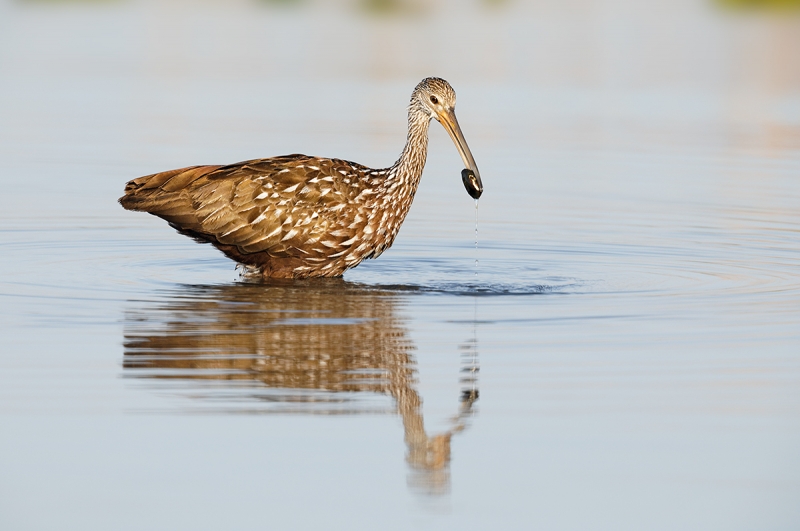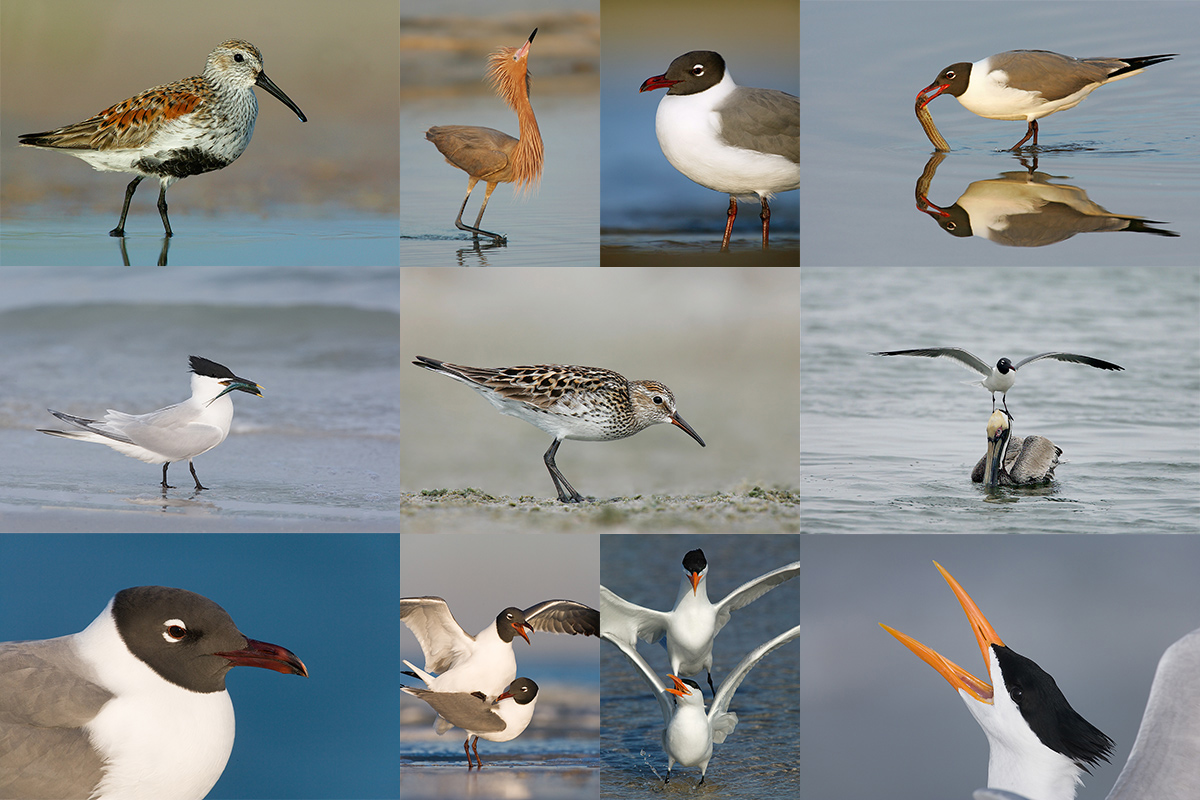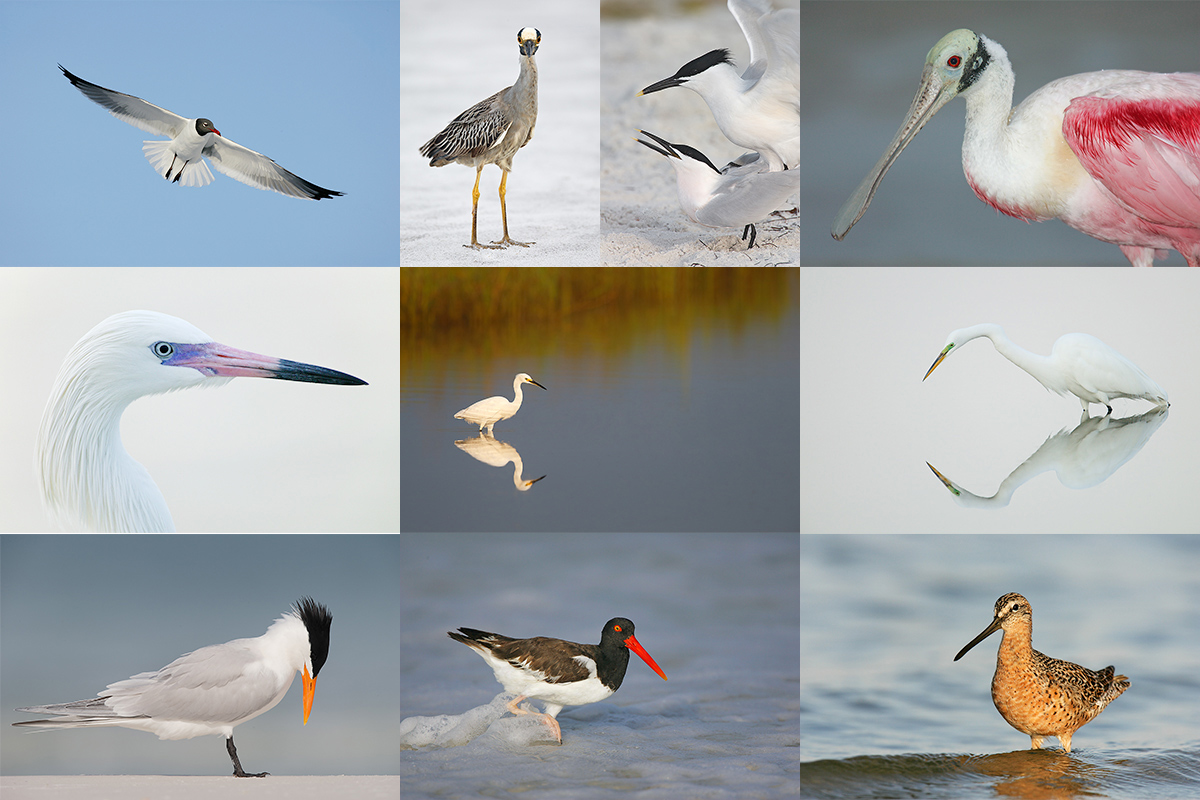What’s Up?
On Wednesday morning I headed down to the lake again and ran into a fairly distant feeding aggregation of Great and Snowy Egrets, Little Blue Herons, a single Great Blue Heron, and White Ibises of all ages. Photography was very tough and I’ve only peeked at the images, but I know that I created at least one good one.
My Mom — who is 94 — took a big downward turn on Monday and Tuesday. I am at the Orlando Airport as I type flying up to Long Island’s Islip to say goodbye (just in case) and tell her what a great Mom she has been. I hope she is alive when I get there on WED evening. I was planning to fly up next week but did not want to wait until then so I bought my ticket on the spur of the moment on Wednesday morning. She is now pretty much confined to bed and when we talked last night her voice was as weak as I have ever heard it. And she has been sleeping the better part of two days. That said, her death has been predicted several times before during the last two years … Like my Dad, she is tough. Who knows?
ps: I just spoke to my Mom and my younger sister Arna. Amazingly, my Mom is doing much better today 🙂
Gear Questions and Advice
Too many folks attending BAA IPTs and dozens of folks whom I see in the field, and on BPN, are–out of ignorance–using the wrong gear, especially when it comes to tripods and more especially, tripod heads… Please know that I am always glad to answer your gear questions via e-mail.
The Streak: 13!
Today’s blog post marks a totally insane, irrational, illogical, preposterous, absurd, completely ridiculous, unfathomable, silly, incomprehensible, what’s wrong with this guy?, makes-no-sense, 13 days in a row with a new educational blog post. As always–and folks have been doing a really great for a long time now–please remember to use our B&H links for your major gear purchases. For best results use one of our many product-specific links; after clicking on one of those you can continue shopping with all subsequent purchases invisibly tracked to BAA. Your doing so is always greatly appreciated. Please remember: web orders only. And please remember also that if you are shopping for items that we carry in the BAA Online Store (as noted in red at the close of this post below) we would of course appreciate your business.
Gatorland In-the Field Instructional Meet-Up Sessions
Join us in Kissimmee, FL this coming weekend to photograph Great (with chicks in the nest) and Snowy Egrets in breeding plumage, Cattle Egret and Tricolored Heron in breeding plumage, Wood Stork, American Alligator (captive), and more. We should get to make lots of head portraits of all the bird species and to photograph them building nests, displaying, copulating, and flying. Learn to see, find, and make the shot in cluttered settings. Learn exposure and how to handle WHITEs. Learn fill flash and flash as main light. All of the birds are free and wild.
Debra Lucas has signed up for all day SAT; she will be driving down from AL.
This Coming Weekend’s Schedule
- Saturday April 1, morning (early entry): 7:30 till 10:30am: $100. Lunch and Image Review: $75. Saturday afternoon till closing (late stay): $100.
- Sunday morning April 2, (early entry): 7:30 till 10am: $75.
Next Weekend’s Schedule
- Saturday April 8, morning (early entry): 7:30 till 10:30am: $100. Lunch and Image Review: $75. Saturday afternoon till closing (late stay): $100.
- Sunday morning, April 9, (early entry): 7:30 till 10am: $75.
Cheap Canon lens rentals available: 600 II, 500 II, 400 DO II, or 200-400.
To pay for one or more sessions in full via credit card, call Jim or Jen in the office weekdays at 863-692-0906. You will be responsible for the cost of your Gatorland Photographer’s pass or passes. Please shoot me an e-mail if you have any questions.
|
|
|
This image was created from my Toyoto Sequoia down by the lake near my home at Indian Lake Estates, FL with the BLUBB-supported Induro GIT 304L/Mongoose M3.6-mounted Canon EF 600mm f/4L IS II USM lens, the Canon Extender EF 2X III, and my very favorite bird photography camera body, the Canon EOS 5D Mark IV. ISO 400. Evaluative metering +2/3 stop: 1/500 sec. at f/9 in Manual mode. AWB. LensAlign/FocusTune micro-adjustment: -5. One AF point to the left and one AF point up from center AF point/AI Servo/Expand/Shutter Button AF was active at the moment of exposure. The selected AF point on the lowest part of the folded wing just behind the side of the lower breast. Limpkin with fresh water mollusk |
Who Would I Be Without My BLUBB?
One thing is for sure, photographing from the car with a big lens and a TC would be a lot more difficult without the BLUBB. This large heavy beanbag is available only from BIRDS AS ART. Working with the BLUBB rather than with one of the many other cheaper beanbags will absolutely produce sharper images and allow for the use of slower shutter speeds.
The BLUBB is made of durable nylon pack cloth and each section is individually hot-cut to sear the edges; this prevents raveling. As nylon can be rather noisy and slippery, the surface that the lens is placed on has a layer of heavy duty cotton duck fabric sewn on top of the nylon fabric. The entire upper surface of the BLUBB is concave so that the lens will stay put. The inner surfaces that are placed over the door-frame or car window have a large piece of Toughtek non-slip fabric sewn in place to help keep the bag from slipping, especially in vehicles where the driver’s window angles downward to the right. All of the fabrics have a water-repellent (but not water-proof) finish. The entire bag is sewn with nylon thread used in the parachute industry. The bag closes with a top quality YKK nylon zipper. All seams are sewn twice to help prevent failure. The bags are made in the USA and each is individually hand-sewn to extremely high standards.
BLUBB (and other large beanbag) Tips
If you need to raise the window a bit with the BLUBB in place, it is best to grab the bag and pull up on it with your left hand while using your right hand on the control to raise the window. This will avoid damaging the motor that raises the window. Lowering the window with the BLUBBin place will not cause any problems.
When using autofocus (which I do 99.99% of the time) be sure that the focusing ring does not rest on the surface of your beanbag. If it does, you will lose sharp focus as you move the lens side to side to track a subject (such as a feeding Limpkin). There are two viable options depending on the size and shape of your long lens. One is to place the section of the lens barrel right behind the hood on the bag, the other is to place the section right behind the focusing ring on the bag. I actually vary my approach with the 600 II depending on the exact situation.
Raise the ISO With Moving Subjects
When in doubt as to whether you have a sharp enough shutter speed, always err in favor of going to the next higher full-stop ISO so that you can double your shutter speed. As the Limpkin in today’s featured image was walking slowly while foraging, I debated going to ISO 800 and working at 1/1000 second instead of remaining at ISO 400 and working at 1/500 second. I should have. Why? Out of 20 images I had exactly two sharp ones. When a bird is perched or otherwise at rest, I have no problem creating consistently sharp images at 1/60 second (just as I do when on the tripod).
The Mollusk Question …
I think that the prey item in today’s featured image may be a small species of freshwater mussel. If you know the species name, or are sure that it is not a freshwater mussel, please let us know by leaving a comment below.
|
DeSoto in spring is rife with tame and attractive birds. From upper left clockwise to center: breeding plumage Dunlin, dark morph breeding plumage Reddish Egret displaying, breeding plumage Laughing Gull/front end vertical portrait, breeding plumage Laughing Gull with prey item, Laughing Gull on head of Brown Pelican, screaming Royal Tern in breeding plumage, Royal Terns/pre-copulatory stand, Laughing Gulls copulating, breeding plumage Laughing Gull/tight horizontal portrait, Sandwich Tern with fish, and a really rare one, White-rumped Sandpiper in breeding plumage, photographed at DeSoto in early May. |
Fort DeSoto Spring IPT/April 19-22, 2017. (meet & greet at 2pm on Wednesday April 19 followed by an afternoon session) through the full day on Saturday April 22. 3 1/2 DAYs: $1599. Limit 10/Openings 2. To save your spot, please call and put down a non-refundable deposit of $499.00.
Fort DeSoto is one of the rare locations that might offer great bird photography 365 days a year. It shines in spring. There will Lots of tame birds including breeding plumage Laughing Gull and Royal and Sandwich Terns. With luck, we will get to photograph all of these species courting and copulating. There will be American Oystercatcher and Marbled Godwit plus sandpipers and plovers, some in full breeding plumage. Black-bellied Plover and Red Knot in stunning breeding plumage are possible. There will be lots of wading birds including Great and Snowy Egrets, both color morphs of Reddish Egret, Great Blue, Tricolored and Little Blue Heron, Yellow-crowned Night-Heron, and killer breeding plumage White Ibis. Roseate Spoonbill and Wood Stork are possible and likely. We should have lots of good flight photography with the gulls and terns and with Brown Pelican. Nesting Least Tern and nesting Wilson’s Plover are possible.
We will, weather permitting, enjoy 7 shooting sessions. As above, our first afternoon session will follow the meet and greet at 2pm on Wednesday April 19. For the next three days we will have two daily photo sessions. We will be on the beach early and usually be at lunch (included) by 11am. We will have three indoor sessions. At one we will review my images–folks learn a ton watching me choose my keepers and deletes–why keep this one and delete that one? The second will be a review of your images so that I can quickly learn where you need help. For those who bring their laptops to lunch I’d be glad to take a peek at an image or three. Day three will be a Photoshop session during which we will review my complete workflow and process an image or two in Photoshop after converting them in DPP. Afternoon sessions will generally run from 4:30pm till sunset. We photograph until sunset on the last day, Saturday, April 22. Please note that this is a get-your-feet and get-your-butt wet and sandy IPT. And that you can actually do the whole IPT with a 300 f/2.8L IS, a 400 f/4 ID DO lens with both TCs, or the equivalent Nikon gear. I will surely be using my 500 II as my big glass and have my 100-400 II on my shoulder.
|
DeSoto in spring is rife with tame and attractive birds. From upper left clockwise to center: Laughing Gull in flight, adult Yellow-crowned Night-Heron, copulating Sandwich Terns, Roseate Spoonbill, Great Egret with reflection, Short-billed Dowitcher in breeding plumage, American Oystercatcher, breeding plumage Royal Tern, white morph Reddish Egret, and Snowy Egret marsh habitat shot. |
What You Will Learn
You will learn to approach free and wild birds without disturbing them, to understand and predict bird behavior, to identify many species of shorebirds, to spot the good situations, to understand the effects of sky and wind conditions on bird photography, to choose the best perspective, to see and understand the light, to get the right exposure every time after making a single test exposure, and to design pleasing images by mastering your camera’s AF system. And you will learn how and why to work in Manual mode (even if you are scared of it).
The group will be staying at the Red Roof Inn, St. Petersburg: 4999 34th St. North, St Petersburg, FL 33714. The place is clean and quite inexpensive. Please e-mail for room block information. And please call Jim or Jennifer at 863-692-0906 to register. All will need to purchase an Annual Pass early on Tuesday afternoon so that we can enter the park at 6am and be in position for sunrise opportunities. The cost is $75, Seniors $55. Tight carpools will be needed and will reduce the per person Annual Pass costs. The cost of three lunches is included. Breakfasts are grab what you can on the go, and dinners are also on your own due to the fact that we will usually be getting back to the hotel at about 9pm. Non-photographer spouses, friends, or companions are welcome for $100/day, $350 for the whole IPT.
BIRDS AS ART Fort DeSoto In-the-Field Meet-up Workshop (ITFW): $99
Fort DeSoto Spring In-the-Field Cheap Meet-up Workshop (ITFW) on the morning of Sunday, April 23, 2017: $99
Join me on the morning of Sunday April 23, 2017 for 3-hours of photographic instruction at Fort DeSoto Park. Beginners are welcome. Lenses of 300mm or longer are recommended but even those with 70-200s should get to make some nice images. Teleconverters are always a plus.
You will learn the basics of digital exposure and image design, autofocus basics, and how to get close to free and wild birds. We should get to photograph a variety of wading birds, shorebirds, terns, and gulls. This inexpensive morning workshop is designed to give folks a taste of the level and the quality of instruction that is provided on BIRDS AS ART Instructional Photo-tours. I hope to meet you there.
To register please call Jim or Jennifer during weekday business hours with a credit card in hand to pay the nominal registration fee. Your registration fee is non-refundable. You will receive a short e-mail with instructions, gear advice, and meeting place one week before the event.


Please Remember to use my Affiliate Links and to Visit the New BAA Online Store 🙂
To show your appreciation for my continuing efforts here, we ask, as always, that you get in the habit of using my B&H affiliate links on the right side of the blog for all of your photo and electronics purchases. Please check the availability of all photographic accessories in the New BIRDS AS ART Online Store, especially the Mongoose M3.6 tripod head, Wimberley lens plates, Delkin flash cards and accessories, and LensCoat stuff.
As always, we sell only what I have used, have tested, and can depend on. We will not sell you junk. We know what you need to make creating great images easy and fun. And please remember that I am always glad to answer your gear questions via e-mail.
I would of course appreciate your using our B&H affiliate links for all of your major gear, video, and electronic purchases. For the photographic stuff mentioned in the paragraph above, and for everything else in the new store, we, meaning BAA, would of course greatly appreciate your business. Here is a huge thank you to the many who have been using our links on a regular basis and those who will be visiting the New BIRDS AS ART Online Store as well.
Be sure to like and follow BAA on Facebook by clicking on the logo link upper right. Tanks a stack.
Typos
In all blog posts and Bulletins, feel free to e-mail or to leave a comment regarding any typos or errors. Just be right :).

















It has been suggested to use dry pinto beans as the filler in the BLUBB. Do these ever sprout, or mildew, or rot, or otherwise decay—especially in a humid climate? We are wet nine months of the year here in the Pacific northwest, and I am hesitant to use beans. Might there be other substances one could use?
HI Max, Thanks for your purchase. I have never had a problem with the beans sprouting. You might try sand which would make the bag mega-heavy or the polystyrene foam peanuts or some other type of filler. With the latter the bag will be much lighter but the support will not be quite as good (less firm) as with the beans.
Best might simply be to store the bag in a cool dry place in your home.
artie
Photography and a ready, nutritious snack – who could ask for anything more?
Hope your Mom is improving.
Thinking good thoughts for you and your family.
I am keeping your Mom and your family in my thoughts and prayers!
Artie, I hope your Mom recovers and All is well.
Artie,
Thinking about you and your mom. Hope she recovers.
Hi Artie – It is definitely a freshwater mussel, Elliptio jayensis (Florida Spike) I think without a blown-up view. This species occurs commonly in aquatic habitats throughout peninsular Florida where their main diet is apple snails and freshwater mussels.
I meant that the limpkin’s main diet consists of apple snails and freshwater mussels.
Thanks stack.
artie
I wish you “Refuah Shlema” for your Mom…..
Ruthie